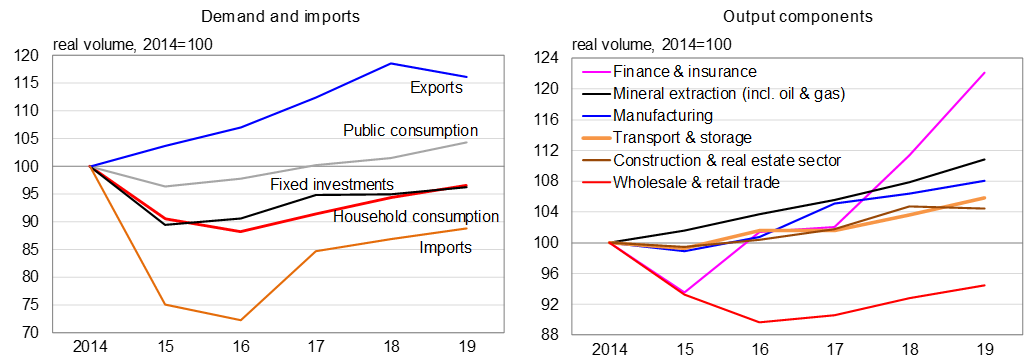BOFIT Weekly Review 07/2020
Rosstat reports Russian GDP up 1.3 % in 2019; revises figures for previous years
Last year, Russian GDP grew at its slowest pace in three years as growth averaged slightly over 2 % a year in 2017–2018. The recovery of imports slowed a bit to just over 2 %. Household consumption, by far the largest demand component, was even more the main driver of growth than earlier, although its growth slowed considerably to 2.3 %. Growth in public consumption gained notably. Even if fixed investment was up just 1.4 % in 2019, it was still an improvement from zero growth in 2018. In contrast, the volume of exports fell by 2 %, after rising every year since 2010.
Russian real GDP was nearly 4 % larger than its 2014 level, the year preceding the previous dip. The same applies to public consumption. The export volume was 16 % higher than in 2014, however. Household consumption and fixed investment were more than 3 % below their 2014 levels, while the import volume was down 11 % from 2014.
Revised Rosstat data for 2014–2018 show that GDP grew slightly more during three years in the period than shown by last autumn’s data. The change reflected better-than-reported increases in household and public consumption. In contrast, growth in fixed investment fell to virtually zero in 2018. The new data also show that the ratio of fixed investment to GDP was just 20.5 % in 2018 and slightly over 21 % in 2019.
GDP growth in 2019 was largely driven by the same sectors as in 2018. The financial sector, trade and extractive industries, led by natural gas, continued to grow rapidly. After two years of value-added growth in the real estate sector, growth halted. Growth of value-added in manufacturing remained relatively slow.
Big differences in trends of Russian GDP components; gradual recovery in imports

Source: Rosstat.